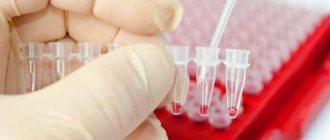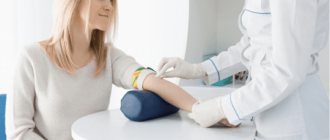How to collect feces from a baby?
When a doctor prescribes a coprogram, the mother immediately has a question: how to take a stool test for newborns? Of course, if an older child can be put on a potty, then this option is not suitable with a baby.
First of all, you need to prepare a sterile container - this is a plastic cup complete with a small spatula. The container is closed with a lid. You can stick a piece of paper on it indicating the child’s name and the date the material was collected.
So, how to collect feces from a baby? To do this you will need the following:
- Pharmaceutical container with spoon;
- Reusable oilcloth;
- Urinal;
- Gas outlet tube;
- Vaseline oil.
Important: when feces are collected on worm eggs, you should not wash the child with various hygiene products - this will significantly distort subsequent laboratory diagnostic results.
Indeed, it is much easier to collect a stool sample from a child if the mother knows when the baby wants to go to the toilet. If the living space is warm, it is recommended to leave the child on a reusable oilcloth. Afterwards, you need to wait until the child goes to the toilet and collect biological material.
How much feces do you need, how to collect it correctly, parents ask? As already noted, a special spatula is included with the feces container. Use this spoon to collect the feces and carefully place them in a container - volume 5-10 g.
How to get tested correctly if your child is constipated? There are a couple of options to help the baby. For example, through a gas outlet tube. The newborn is placed on an oilcloth, the legs are bent and the tube is carefully inserted into the anus - but first Vaseline is applied to it. This process will help you have a bowel movement. However, it should be noted that in the latter case, a stool test for worm eggs may show a false positive or false negative result, since Vaseline was used.
Preparing for analysis
Moms are wondering how to properly test their child for eggworm? If the doctor recommended scraping for the eggworm, then the procedure is quite simple and no special preparation is required. If a stool test for worm eggs (research) needs to be collected, then a smear is much easier to perform.
There are two methods: use a cotton swab or special adhesive tape. In the first case, the scraping test for ovules is done as follows: lift the child’s legs, gently spread the buttocks, and run a cotton swab along the anal folds. Place the stick in the container and close the lid.
In the second case, adhesive tape is pasted in the anal area and then applied to a glass slide. The biological material is submitted to the laboratory. They take it in the morning; you cannot wash the child, even with clean running water.
Stool coprogram in infants requires certain preparation for analysis:
- Seven days before the study, no complementary foods should be introduced;
- Do not give the child medications, laxatives, etc.
How long is a stool test valid for a baby? Coprogram of feces in newborns and infants can be stored in a closed container for 8-10 hours. At room temperature no more than four hours. In summer, it is recommended to use a refrigerator bag for transportation to the laboratory.
Advice: if you need to take a stool test for worms at a certain time, then a light massage of the tummy in a clockwise direction using slight pressure will help speed up the process of defecation. You can try bending the baby's legs at the knees and gently pressing them to the stomach.
Please note that in order to test stool for worm eggs to give a reliable result, you need to make sure that no urine gets into the biological material. As practice shows, not all parents manage to collect feces the first time.
What not to do when collecting stool analysis
It is difficult to collect feces from a baby; parents resort to many tricks that can distort the result.
- You should not keep feces in the refrigerator for more than 8-10 hours . The longer the material is stored, the more actively microorganisms and bacteria begin to multiply in it, which can blur the whole picture and, at best, you will have to retake the analysis, and at worst, an incorrect diagnosis .
- Do not freeze feces in the freezer.
- You cannot give your child an enema or laxative suppositories , etc. Feces extracted using an enema will be diluted with water, and this reduces its “shelf life” to almost zero. And if you induce stool with a candle, its impurities will remain in the stool.
- A child with suspected dysbiosis should not be introduced to the diet with new foods several days before the test.
Decoding coprograms in children
Stool tests for worm eggs provide only two results - negative and positive. Accordingly, in the first case, no eggs were found, in the second, a certain amount was found. But not everything is as simple as it might seem at first glance.
A negative result does not mean the absence of a parasitic disease, since the likelihood of a false test is due to the vital activity of some types of helminths. To ensure the absence of parasites, the child's stool is analyzed at least three times every five days.
The interpretation of stool analysis depends on the child’s nutrition - the indicators for breastfed and bottle-fed babies are slightly different. Normally, the analysis should be as follows:
- The consistency during breastfeeding is mushy, compared to the adapted formula it is somewhat thicker.
- In the form, stool tests for worm eggs are “negative”. If positive, then additional tests are prescribed, for example, donating blood for parasites.
- A small number of leukocytes is normal. Their growth indicates the development of an inflammatory process, including that it can be triggered by the activity of helminths in the body.
- When breastfed, the environment is acidic; when using an adapted formula, it is slightly acidic.
- If the baby feeds on the mother's breast, then a small amount of mucus is allowed; if he eats formula - no.
- There should be no blood impurities regardless of the child’s diet.
- The presence of a small concentration of fatty acids is normal.
Important: if the baby has been prescribed a test for the presence of Giardia, then the feces are taken to the laboratory as quickly as possible - preferably while still “warm”. Since the more time passes, the lower the probability of obtaining the correct result.
By following the recommendations described above, parents will not encounter the problem of collecting feces from their newborn child. The main thing is to maintain sterility as much as possible at home, and also adhere to shelf life.
Summary of the article
Stool analysis is done quite often, especially in childhood, to monitor the state of the digestive system. Collecting feces from infants is a responsible undertaking, primarily for parents, on which the correct interpretation of the result depends. This article will help you figure out how to properly take a stool test.
About stool tests
Poo (or feces) is usually thought of as nothing more than waste—something that can be quickly flushed away.
But bowel movements can give doctors valuable information about what's wrong when a baby has problems in the stomach, intestines or another part of the gastrointestinal system. Your doctor may order a stool collection to test for a variety of possible conditions, including:
- an allergy or inflammation in the body, such as part of the evaluation for milk protein allergy in infants
- an infection caused by certain types of bacteria, viruses, or parasites that invade the gastrointestinal system
- digestive problems, such as malabsorption of certain sugars, fats or nutrients
- bleeding inside the gastrointestinal tract
The most common reason for stool testing is to determine whether a type of bacteria or parasite may be infecting the intestines. Many microscopic organisms living in the intestines are necessary for normal digestion. However, if the intestines are infected with harmful bacteria or parasites, it can cause problems such as some types of bloody diarrhea, and a stool test can help find the cause.
Stool samples are also sometimes analyzed to see what they contain; for example, fat content is examined. Normally, fat is completely absorbed from the intestines, and stool contains virtually no fat. However, in some types of digestive disorders, fat is not completely absorbed and remains in the stool.
What does a stool test show?
Stool analysis can become the most important diagnostic tool in the hands of a competent specialist. To find out the general condition of the body, scatology (general stool analysis) is done - it will allow you to assess the condition of the digestive tract and identify deviations in its functioning. A stool test for coprogram is done in almost any clinic or diagnostic center. Based on the results of the analysis, parents will learn about the presence of undigested food particles, starch, protein, blood, and bilirubin in the stool. Other physical and chemical indicators are also assessed. There are also highly targeted stool studies.
- For parasites. This type of analysis includes tests for Giardia cysts and helminth eggs (worms). In this case, laboratory technicians are faced with the task of seeing signs of infection of the body by one of the pathogens, and other parameters are not examined.
- For dysbacteriosis. Prescribed for frequent diarrhea, alternating with constipation, bloating, flatulence, colic. If the activation of opportunistic microflora is to blame, then a bacteriological test will show this, and the doctor will then prescribe appropriate treatment.
- For hidden blood. Performed if bleeding is suspected. Normally, it should not be present, therefore, if hidden blood is detected, the doctor suspects gastric bleeding, peptic ulcer and other pathologies.
- For rotavirus. Quite often in childhood, children become victims of rotavirus infection. Excessive vomiting, fever and signs of intoxication are typical symptoms of rotavirus infection. When analyzing stool for rotavirus, it is possible to identify the pathogen and exclude other serious pathologies.
- For calprotectin. Prescribed if a small patient is underweight, has general weakness, constipation and diarrhea. This is a neutrophil protein that is a marker of intestinal inflammation. If it is detected in the stool, doctors suspect ulcerative colitis or Crohn's disease, in which the intestinal mucosa becomes inflamed. In some pathologies (cystic fibrosis, celiac disease, diverticula), inflammation can be a consequence.
- For carbohydrates. It is carried out if lactase deficiency is suspected. A study using the Benedict method allows you to establish intolerance to milk and dairy products, which is extremely important when switching to artificial feeding.
How to get tested correctly: recommendations for mom
Before doing this, you should prepare everything you need to collect stool:
- a sterile plastic jar from a pharmacy with a spoon;
- sterile diaper or oilcloth;
- a potty washed with baby soap - for older children.
Important! It is best to collect feces from a baby not from the diaper. It is saturated not only with feces, but also with urine, and this is not permissible during research.
You need to be ready to collect feces in the morning, but you should not forget about this possibility during the daytime hours, because the process is reflexive and is not regulated by a strong-willed decision to “be patient” when the mother is ready. After observing the baby, you can notice the child's urge to defecate - the children calm down, become concentrated, with tight stool, you can notice a reddened face and beads of sweat on the forehead when the baby pushes.
Collection of biomaterial must be done immediately after defecation in a clean, dry container. As a last resort, collecting feces in household dishes is allowed. It is necessary to take glassware that has been previously washed and dried. The container must be sealed tightly and the child’s name and age must be signed.
How to collect feces from a baby in a jar for analysis
If defecation begins.
- The child needs to place a pre-prepared oilcloth or diaper under his butt. Any clean oilcloth or the reverse side of a diaper diaper will do - they also have a layer of polyethylene. In this case, you can be sure that no lint or diaper strings will get into the feces.
- Thick stool is collected with a stool spoon attached to the lid of the container.
- Liquid feces are poured from an oilcloth placed under the baby’s bottom.
- The container is then tightly sealed and sent to the laboratory. The analysis collected the night before can be stored in the refrigerator.
If there is no bowel movement for a long time.
- The child needs to place a pre-prepared oilcloth or diaper under his butt.
- Massage the tummy, stroking it with light pressure with your palm in a clockwise direction. Then press the baby's legs, bent at the knees, to the tummy. Perform stroking and exercises alternately.
- Next, you can try to stimulate the anus with a gas tube, the tip of which is lubricated with Vaseline.
- If necessary, repeat step 2 and step 3 sequentially.
How much stool does a baby need for analysis? On average , to carry out any analysis, it is necessary to collect a volume equivalent to 1-2 teaspoons - this is quite enough to evaluate the necessary indicators.
Is special training needed?
- Special preparation in the form of washing is not required if normal daily hygiene procedures are followed.
- If your baby is taking antibacterial drugs, you must notify your doctor about this. For some tests, taking antibacterial agents may not be acceptable, so the doctor may reschedule the stool sample.
- When carrying out a coprogram, the use of antibiotics and enzyme preparations is clearly excluded.
- When conducting a test for occult blood, it is necessary to exclude tomatoes, fish products and meat from the child’s diet three days before collecting biomaterial, so as not to get a false positive result.
- When analyzing stool for digestive enzymes, it is prohibited to give enzyme preparations three days in advance, otherwise you may get incorrect data.
Feces cannot be donated in some cases:
- if the child was given laxatives or suppositories;
- if an enema was done;
- when mixing feces with urine.
How to collect a stool sample
Unlike most other laboratory tests, stool is sometimes collected by the child's family at home rather than by a health care professional. Here are some tips for collecting a stool sample:
- Collecting stool may not be sterile, so be sure to wear latex gloves and wash your and your baby's hands well afterward.
- Many children with diarrhea, especially young children, cannot always tell their parents in advance when a bowel movement will occur. Sometimes a plastic cap shaped like a hat is used to collect the stool sample. This collection device can be quickly placed over the toilet or your baby's backside to collect a sample. Using a catching device helps prevent water and dirt from contaminating the stool. If urine contaminates the stool sample, another sample will need to be collected. Additionally, if you cannot catch the stool sample before it touches the inside of the toilet, the sampling will need to be repeated. Fishing stool out of the toilet does not provide a clean sample for analysis in the laboratory.
- Another way to collect a stool sample is to place plastic sheeting loosely across the edge of the toilet, under the seat. Then place the stool sample in a clean, airtight container before sending it to the laboratory. Plastic wrap can also be used to wrap the diaper of an infant or toddler who is not yet using the toilet.
Stool should be collected in clean, dry plastic jars with screw caps. You can get them from your doctor or through hospital laboratories or pharmacies, although any clean, airtight container may be an appropriate container. For best results, stool should be taken to the laboratory immediately.
If a stool sample will be tested for infection and it is not possible to immediately transport the sample to the laboratory, then the stool should be refrigerated and then transported to the laboratory for culture as soon as possible after collection. When the sample arrives at the laboratory, it is either immediately examined and cultured, or placed in a special liquid medium that attempts to preserve potential bacteria or parasites.
The doctor or hospital laboratory usually provides written instructions on how to successfully collect a stool sample; If written instructions are not provided, make notes on how to collect the sample and what to do after you have collected it.
If you have any questions about how to collect a sample, be sure to ask. Your doctor or lab technician will also tell you whether you need a fresh stool sample for a particular test, and if you need one, it will need to be taken to the lab immediately.
In most cases, pathogenic bacteria or parasites can be identified from a single stool sample. However, sometimes it is necessary to take up to three samples. The doctor will let you know if this is the case.











